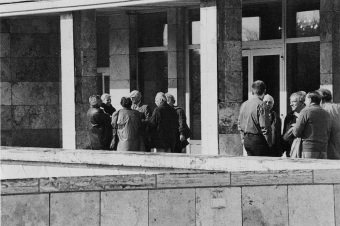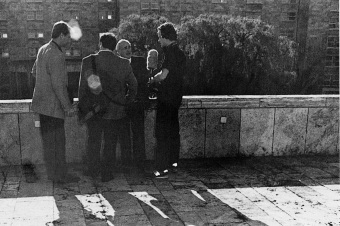Survivors’ Meeting in 1998

© Fritz Bauer Institute

© Fritz Bauer Institute
In October 1998, at the invitation of the Fritz Bauer Institute, survivors of the Buna/Monowitz concentration camp met in the former head office of I.G. Farbenindustrie AG in Frankfurt am Main.
Former forced laborers for I.G. Farben who are, or were, members of the Survivors’ Council of the Fritz Bauer Institute had expressed a wish to organize such a meeting. Around 90 survivors from all across the world gathered in Frankfurt am Main. The main purpose of the get-together was to meet old comrades again. But the survivors were also willing to talk with school pupils, visit schools, and share their personal stories in focus groups. Meeting with young people was a major concern for the contemporary witnesses. Readings from published testimonies and talks by historians were organized, and “I.G. Auschwitz,” an exhibition developed by the Fritz Bauer Institute, was presented. The plan to shed light on the history of I.G. Farben under National Socialism and on the history of the I.G. Auschwitz plant, to place the future campus of the Johann Wolfgang Goethe-University, the I.G. Farben Building, in an appropriate historical context, was successful, thanks to the meeting and the contributions of the survivors.
Efforts to spirit away the legacy of the policy of the Nazi past, a legacy taken on by the Goethe University with its move into the former corporate headquarters of I.G. Farben—for example, the effort to change the name of the I.G. Farben Building to the “Poelzig Building”—met with failure, not least because of the commitment of the Buna/Monowitz survivors.
At the opening event for the gathering, Christine Hohmann-Dennhardt (SPD), then the Hessian Minister for Science and Art, read aloud the text for the memorial plaque that was to be placed in front of the I.G. Farben Building when the university moved into its new quarters. In October 2001, the plaque was formally unveiled in the presence of survivors of the Buna/Monowitz camp. The final version of the text for the commemorative plaque had required more discussion in the university administration and the committee responsible for the plaque. In his address at the dedication of the plaque, Prof. Dr. Micha Brumlik, then the head of the Fritz Bauer Institute, made public a thought that gave rise to quite a bit of controversy in the following years. Brumlik raised the survivors’ vehemently supported demand that the Grüneburgplatz, the address of the Goethe University in the I.G. Farben Building, be renamed the “Norbert-Wollheim-Platz.” The idea failed to meet with approval and could not be implemented. As an alternative to the proposed renaming of the Grüneburgplatz, the concept of a “Norbert Wollheim Memorial” was developed. Through video interviews with survivors of the Buna/Monowitz concentration camp, the website www.wollheim-memorial.de, and the provision of sources, it offers an opportunity to deal with the recent past, which continues to make itself felt in the present.
(WR; transl. KL)
















